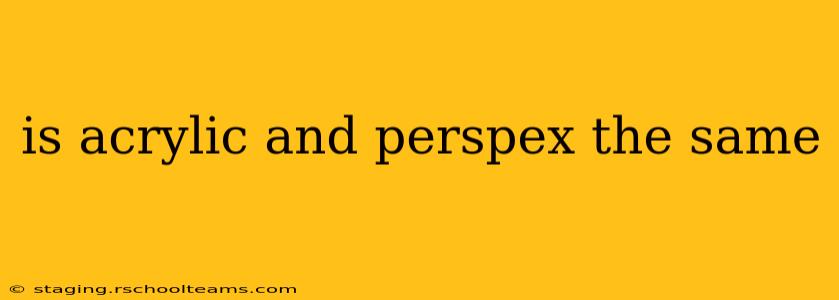Is Acrylic and Perspex the Same? Understanding the Difference
The question of whether acrylic and Perspex are the same often arises, and the answer is nuanced. While often used interchangeably, there's a key distinction: Perspex is a brand name, while acrylic is the material itself. Think of it like Kleenex and tissues – Kleenex is a brand of tissue paper, but tissue paper is the general material.
Let's delve deeper into the specifics:
What is Acrylic?
Acrylic is a type of thermoplastic polymer, known for its clarity, strength, and versatility. It's created through a polymerization process involving the chemical methyl methacrylate (MMA). This results in a material that is:
- Lightweight: Significantly lighter than glass, making it easier to handle and install.
- Impact-resistant: Much stronger than glass, less prone to shattering, and therefore safer.
- Weather-resistant: Durable enough to withstand various weather conditions, making it suitable for both indoor and outdoor applications.
- Versatile: Can be easily shaped, cut, and polished, allowing for complex designs and applications.
What is Perspex?
Perspex is a brand name owned by Lucite International, specifically referring to their brand of acrylic sheets. Essentially, Perspex is a type of acrylic. Many companies produce acrylic sheets, but Perspex is one of the most well-known and established brands. When someone refers to "Perspex," they are generally referring to high-quality acrylic sheets produced by Lucite.
Are there differences in quality?
While both are acrylic, the quality can vary between different manufacturers and brands. Perspex, due to its established reputation and rigorous quality control, is often considered a premium option, known for consistent quality and optical clarity. However, many other manufacturers produce high-quality acrylic sheets that are comparable in performance and aesthetics. The price point often reflects this difference in branding and perceived quality.
What are the common uses of acrylic and Perspex?
Both acrylic and Perspex find applications in a wide array of industries and projects, including:
- Signage: Acrylic's clarity and durability make it ideal for creating eye-catching signs and displays.
- Displays: Museums, shops, and galleries utilize acrylic for showcasing products and artifacts due to its transparency and strength.
- Protective coverings: Acrylic sheets protect surfaces from damage, often used in machinery or as protective barriers.
- Architectural applications: Used for windows, skylights, and other architectural elements.
- DIY and crafting: Its ease of use makes it popular among hobbyists and crafters for a range of projects.
What are the alternatives to acrylic and Perspex?
Alternatives to acrylic sheets include:
- Glass: Offers superior optical clarity but is heavier, more fragile, and more expensive.
- Polycarbonate: Offers even higher impact resistance than acrylic, but may be slightly less clear.
- PETG: A more cost-effective option, but slightly less durable and clear than acrylic.
In conclusion, while the terms are often used interchangeably, Perspex is a specific brand of acrylic. The choice between Perspex and other acrylic brands depends on factors like budget, required quality, and specific application. Understanding this distinction helps to clarify the material selection process for your projects.
